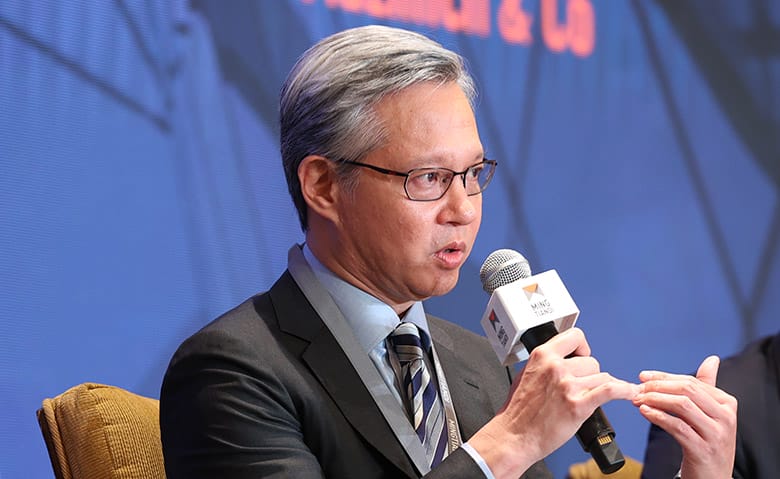Higher interest rates have challenged risk assumptions and valuation drivers in the real estate industry, driving investors in private credit strategies in Asia Pacific to become more cautious in their underwriting when pursuing private credit opportunities in Asia’s real estate sector, according to a panel of investors speaking at Mingtiandi’s Singapore Focus Forum on Tuesday.
At the event, which was sponsored by Yardi, attendees heard from Rai Katimansah, managing director of special situations and direct lending at SC Capital Partners; Foster Lee, senior director of credit investments at Gaw Capital; Jieying Huang, director of Asia Pacific private debt at Muzinich & Co; and Marko Multas, head of Asia investments and real estate debt at Patrizia.
“When you look at valuation reports, if you just slightly change the risk-free rate or cap rate, valuations can change a lot. The risk has definitely increased, especially when you are looking at a valuation report as of January 2023, you can pretty much forget it,” said Gaw Capital’s Lee, whose Hong Kong-based firm has deployed $1 billion into credit investments alongside its real estate private equity business.
Keeping It Conservative
For Singapore-based SC Capital Partners, which manages $6 billion of real estate equity and debt investments in Asia Pacific, adopting a conservative approach is key to its underwriting process, with the fund manager lowering its loan-to-value (LTV) ratios to hedge against elevated default risks.
“We underwrite the property as if we’re going to buy it, so we do ground-up. We don’t just rely on the appraisal report,” said Katimansah. “When base rates were close to zero, default rates were much lower. Four or five years ago, we were looking at things that were 75 percent LTV, but now that base rates are higher, it’s more like 60 to 65 percent. So it’s a lot more downside risk protection.”

Rai Katimansah, Managing Director for Special Situations & Direct Lending at SC Capital Partners
The company’s debt platform invests in special situations and direct lending of primarily senior mortgage loans secured by properties located in mature, credit-friendly Asian jurisdictions.
Manhattan-based Muzinich, a pure-play generalist credit investor with approximately $40 billion in public and private debt assets under management globally, echoed the need for a cautious approach.
““The “V” (in LTV) is a paper V. For private equity, they are taking a 10-year horizon, whereas for private credit, it is a three year loan,” said Huang. “So ultimately, what’s important is your borrower can service the debt in the meantime. You need to take a more conservative approach when it comes to the valuation, because if things don’t work out, if I actually end up having to enforce, is that paper valuation really the real market valuation that you can achieve?”
Muzinich in June closed its inaugural Asia Pacific private debt fund with $500 million in total funding, anchored by a $200 million seed commitment from Singaporean lender DBS. The sector-agnostic fund invests in direct lending and special situations and as of July is 35-40 percent deployed through eight closed investments, mostly across Australia, Hong Kong, and India.
Pockets of Opportunity
While all of the panelists said they are pursuing debt strategies in Australia, a market traditionally favored by Asia Pacific credit investors due to its strong legal system regarding enforcement and collateral, the speakers also highlighted opportunities in other Asian markets.
“Australia is getting quite old, it is very mature. It makes it a market that is highly competitive and the risk-adjusted returns may not be as good as elsewhere,” said Patrizia’s Multas, whose firm is increasing its real estate credit exposure amidst the rising interest rate environment.
For Multas, there is more opportunity in some of the region’s other developed markets. “I think what is interesting is Japan. Part of the reason is we expect interest rates will increase towards the end of the year. And that could open up a very interesting investment opportunity for credit investors in Japan.”
Frankfurt-listed Patrizia has $58 billion of assets under management globally across real estate and infrastructure, of which $1 billion consists of real asset debt.
In addition to Australia and Japan, South Korea is another developed market in Asia that has attracted private credit investors, with SC Capital and Gaw Capital having invested there.
“We like Korea. I think on the development financing side, Korea and Australia are very attractive. Lower LTC (loan-to-cost), lower LTV, and better sponsor quality. These things all add up,” said Katimansah.
Within developing Asia, India, Vietnam, and Indonesia were cited as markets of interest, but the panelists are moving cautiously in those markets due to weaker enforcement systems.
“I’m not a big fan of emerging markets in Asia. The issue that we have is that, if we need to enforce, the legal systems are quite often very weak and it’s very difficult,” said Multas. “So I think that’s not worth the risk when we are seeing solid, real estate double digit returns in various mature markets.”
For Muzinich, Indian assets under management grew 27 percent in the first quarter of this year from $15 billion at the end of last year. However, the fund manager remains cautious in Vietnam.
“For Vietnam, we would take a more cautious approach at this point,” said Huang. “Right now there are a lot of limitations in terms of what we can do as offshore lenders. It’s a market that’s on our radar but it’s still a wait-and-see approach.”
Room to Grow
The panelists noted that private lenders such as themselves are emerging as an alternative financing option for real estate borrowers and complementing traditional lenders like banks, who are typically constrained by restrictions such as single borrower limits and loan size thresholds.
Gaw Capital’s Lee also indicated that banks have cut their real estate exposure since the 2008 financial crisis, with their target markets shifting towards only the largest, publicly-listed developers. Losses on commercial real estate loans in Mainland China in the last few years have also curtailed lending.
This has resulted in growing demand for alternative financing by underserved real estate borrowers. While non-bank lending has exceeded bank lending in developed markets like the US, the early stage of Asia’s private debt market has led the panelists to see room for growth.
“If we look at the overall lending market, APAC private debt is still under-penetrated. To put things in perspective, US non-bank lending accounts for 74 percent of the market. That’s triple bank lending,” said Huang. “In APAC, banks still account for two-thirds of the market, so the trend is reversed. And if you take out Australia from the equation, that ratio is even higher. So there still remains a lot of space for private credit to grow. I think this will continue to be a strategy that will stay relevant.”












Leave a Reply